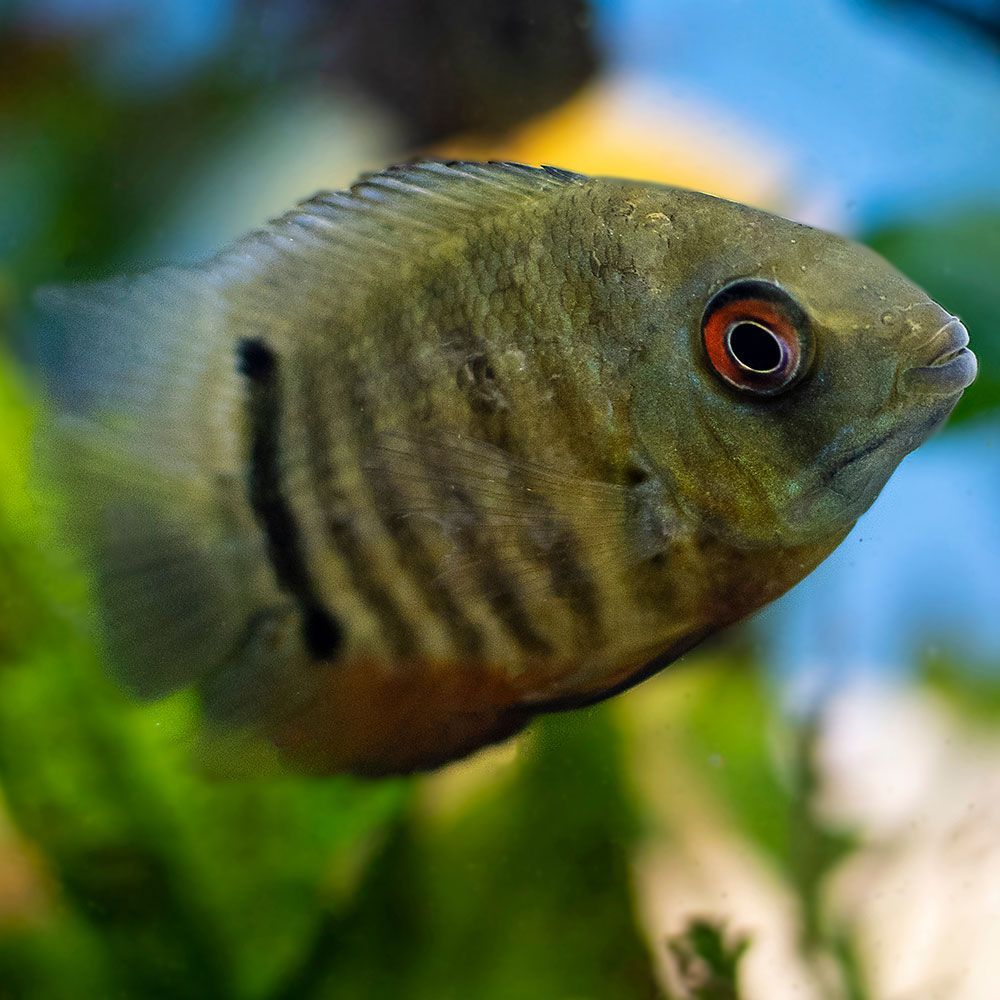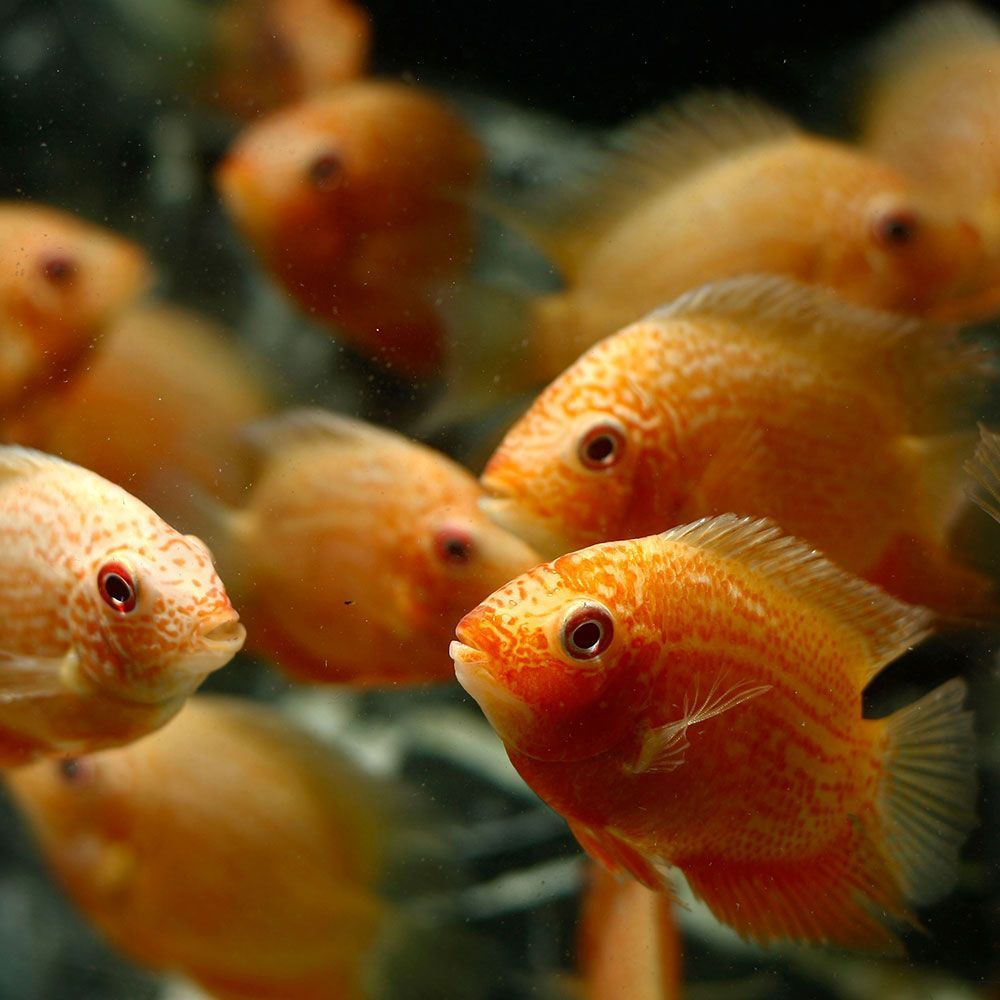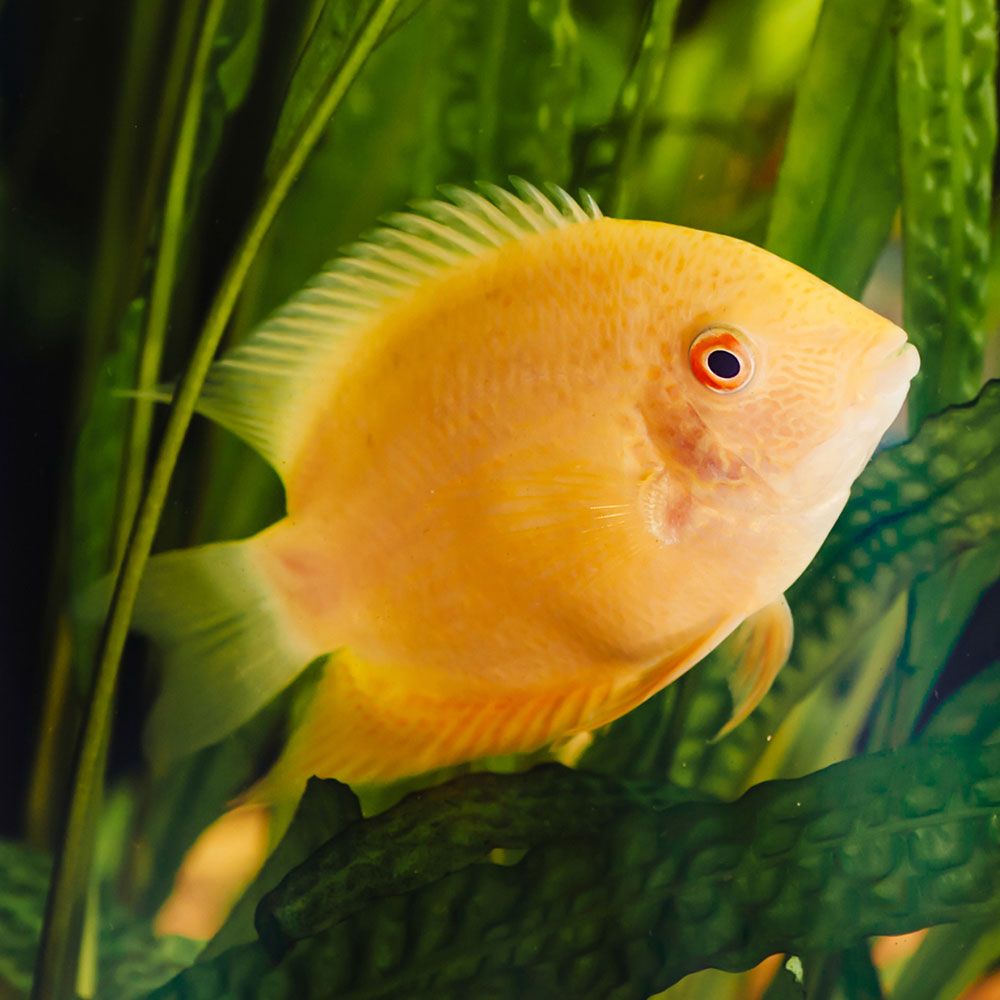If you’re seeking a uniquely colorful yet affordable big fish for your freshwater aquarium, you can bid on severum cichlids with your eyes closed. With their striking colors and unique patterns, they create a visually appealing and lively environment.
Further, it is very easy to care for, so it’s an excellent cichlid for any beginner aquarist. Their calm temperament and engaging behavior won’t keep you on edge, unlike most cichlids of their size!
If you are wondering if you should get these gentle giants, keep reading.
What is a Severum Cichlid?
Severum Cichlid is a big freshwater fish that is available in various colors and is considered a great option for a beginner fish keeper.
| Origin | South America: Orinoco River basin: Colombia and Venezuela, upper Negro River basin in the Amazon River basin. |
| Order | Perciformes |
| Family | Cichlidae |
| Scientific Name | Heros severus |
| Common Names | Striped cichlid, Severum, Sedate cichlid, Deacon, Banded cichlid, Golden severum |
| IUCN Red List Status | Not evaluated |
| Appearance | Rounded shape with strong lateral compressed, orange and silver colored body, distinctive red markings |
| Size | Up to 14 cm (5.5 in) |
| Lifespan | Usually, it takes around 5 years, but under optimal conditions, up to 10 years |
| Temperament | Generally peaceful but can be territorial and aggressive during breeding |
| Tank Level | Middle to bottom of the tank |
| Water Temperature | 73-84 °F (23-29 °C) |
| pH Level | 5-6.5 |
| Water Hardness | Up to 6 dGh |
| Care Level | Moderate |
| Minimum Tank Size | 55 gallons for one, 125 gallons for two |
| Tank Environment | Plenty of hiding spots with rocks, driftwood, plants, and open swimming spaces. |
| Diet | Omnivorous; fond of carnivorous feed |
| Tank Mates | Similarly sized peaceful fish; can coexist with more aggressive cichlids in a well-decorated tank |
Where is Severum Cichlid found?
The severum cichlid is found in the natural habitats of South America. They are particularly found in the Orinoco River basin of Colombia and Venezuela. These fishes are also found in the upper Negro River basin in the Amazon River basin.
These areas are characterized by freshwater conditions with temperatures ranging from 23°C to 29°C.
In their native environment, they prefer regions with slow-moving or still waters with adequate vegetation. They often inhabit areas with rocks, driftwood, and plants where they can find hiding spots.
Which family does Severum Cichlid belong?
The species belongs to the family Cichlidae under the order Perciformes.It is scientifically called Heros severus.
The fish is known by various other common names, including severum cichlid, striped cichlid, severum, sedate cichlid, deacon, golden severum and banded cichlid.
Fun Fact: Severum cichlids are called “poor man’s discus” for they are much cheaper compared to discus fish. But they are equally stunning and captivating.
How does Severum Cichlid look?

If you are now interested in the fish and want to know more about how it looks and what it likes, let’s go!
What is the Size of Severum Cichlid?
The cichlid typically grows up to 14 cm (5.5 in) in length. But the maximum reported length was found to be 20 cm (7.9 in).
What is the Color of Severum Cichlid?
The most common and naturally available severum cichlid has a base green-colored body with golden stripes, yellow eyes, and a white base tail with specks of yellow.
But there are other color variants available, like the red-spotted severum, red shoulder (or rotkeil or necktie) severum, golden severum, turquoise severum, green severum, blue severum, and white severum.
As they age, these cichlids become more attractive with intensifying and vibrant colors.
What are the Features of Severum Cichlid?
Severum cichlids feature large, oval-shaped, and compressed bodies with a golden hue covering their entire frames.
The bands along their sides are vibrant in juveniles but become duller as they mature.
Fry displays consistent gold colors with burnt orange spots, and over time, the bands on their bodies fade. bonding
They have distinctive sharp anal and dorsal fins. Unlike African and South American Cichlids, Severum cichlids have a flattened, vertically rounded shape, similar to more discus fish.
How is a male Severum Cichlid different from a female?
The male fish is a bit larger than the female ones. In mature males, the dorsal and anal fins tend to be more pointed and have marked gills. Females have a distinct dark spot on their dorsal fin.
What is the Behavior of Severum Cichlid in the tank?
Severum cichlids are generally peaceful, unlike other cichlids. They are suitable for pairing with similar-sized peaceful fish and coexist with more aggressive cichlids in a well-decorated tank.
During breeding, they may become territorial, requiring hiding spots to minimize conflicts.
You must always monitor their behavior, as they may display territorial aggression or attack smaller fish.
What is the Lifespan of Severum Cichlid?
Severum cichlids typically have a lifespan of around 5 years. But in my experience, when kept under optimal conditions, they can live up to 10 years or even longer.
This will require a well-maintained and suitable environment, proper nutrition, regular water quality maintenance, and attentive care.
Author’s Note: This fish changes color based on mood and their environment. During excitement or courtship, their normally greenish hue intensifies, resembling a subtle blush.
How to take care of Severum Cichlid?

If you’re ready to bring home this fish, let’s create its future habitat here!
What is the Tank Size for Severum Cichlid?
To ensure a healthy and stress-free environment for one severum cichlid, a minimum tank size of 55 gallons is recommended.
However, if you plan to have a pair, invest in a 125-gallon tank to provide adequate space and minimize territorial issues.
For a community tank, a larger tank is ideal for harmonious coexistence among all.
What is the Water Chemistry for Severum Cichlid?
Your fish’s health depends severely on the water quality. So, make sure you follow these parameters…
- pH Levels: 5-6.5
- Water Temperature:73-84 °F (23-29 °C)
- Water Hardness: Up to 6 dGh
- Ammonia: 0 ppm
- Nitrite: 0 ppm
- Nitrate: Below 20 ppm
What is the Tank Environment for Severum Cichlid?
The fish thrives the best in a tank that mimics its natural habitat. So, let’s design the best home for them!
Which Substrate does Severum Cichlid need?
These cichlids thrive in fine sand substrates. They enjoy digging and use it as hiding spots.
Soft and fine substrate prevents damage to their delicate fins and also ensures a comfortable environment for resting and seeking shelter from other fish.
Which Plants does Severum Cichlid need?
Similar to its natural habitat, you must add enough vegetation to your tank to provide shelter to the stressed fish. They also gently graze against the leaves, so avoid plants with sharp foliage as they might injure them.
Which Lighting does Severum Cichlid prefer?
Set up the tank environment with minimal lighting. These fish prefer darkness, so special lighting isn’t required, and any suitable lighting can be used.
Excessively bright lights disturb the fish’s comfort and behavior.
Use lights with a timer to ensure they get a maximum of 12 hours’ worth of light daily. This helps to maintain a natural lighting cycle that aligns with their preferences.
What is the Décor for Severum Cichlid tank?
Severums are fond of hiding, so incorporate abundant decorations for them to find refuge. Some options include rocks, caves, driftwood, ceramic plates, and PVC pipes with smoothened edges.
Which filter is needed for Severum Cichlid tank?
Cichlids produce substantial waste, so standard hang-on-back filters may not suffice. Invest in a properly sized canister filter to cycle the water multiple times per hour.
Ensure careful positioning of outlet tubes, as severums prefer gentle water flow. To diffuse the current, place objects in front of filter outlets, preventing fast-moving water.
What is the Water Flow Rate for Severum Cichlid tank?
These fish come from murky and slow-moving waters, so they dislike high water flow. Thus opt for a setup that provides a gentle current.
Fish Care Tip: Maintain good water quality through regular testing and at least 20% water changes to keep your fish healthy and disease-free.
What does Severum Cichlid eat?
Severum cichlids are natural omnivores but love carnivorous treats. They consume both plant and animal matter in the wild. Their diet includes crustaceans, small insects, and plants found in their natural habitat.
In captivity, provide a balanced diet that consists of:
- Fish food flakes
- Pellets
- Mealworms
- Bloodworms
- Algae wafers
- Brine shrimp
High-quality commercial pellets and flakes are recommended as they’re designed to meet cichlids’ specific nutritional needs. You can also opt for frozen and freeze-dried protein-based foods.
Severums thrive with four to five daily meals. They have healthy appetites but avoid overfeeding. Offer food they can consume in a minute during each meal.
What are the Tank Mates for Severum Cichlid?
For severums, it’s best to choose tank mates that are similar in size and have a passive demeanor. For healthy coexistence, consider adding the following:
- Freshwater angelfish
- Blood parrot cichlids
- Redtail black sharks
- Black skirt tetras
- Hoplo catfish
- Moonlight gouramis
- Dwarf gouramis
- Jack Dempsey fish
- Convict cichlids
- Silver dollar fish
- Kissing gouramis
- Pearl gouramis
- Blue gouramis
- Green terror cichlids
Which Tank Mates to Avoid with Severum Cichlid?
Avoid putting the following types of species in your severum tank:
- Aggressive or territorial species: can stress or prey on severums
- Smaller tank mates: severums may consume them when hungry
- Larger species: they may bully severums
What are the Common Diseases in Severum Cichlid?
Like any other fish, severums are also pretty susceptible to most common freshwater fish diseases. So, be prepared to deal with these:
| Disease Name | Causes | Symptoms | Treatment |
|---|---|---|---|
| Ich | External Protozoan Parasite | Flashing, white spotting, appetite loss, lethargy | Add ich medicines or aquarium salts, increase aquarium temperature |
| Fin Rot | Bacterial Infection | Appetite loss, fin discoloration, lethargy, fin fraying or disintegrating | Enhance water quality, antibiotics, remove damaging objects |
| Dropsy | Bacterial and viral infections, poor water conditions, parasites | Hugely swollen belly, protruding scales, reddened skin near fins and vents | isolate the affected individual, change water, antibiotics, aquarium salts. |
| Columnaris | Bacterial Infection | White/gray patches, appetite loss, fin fraying, lethargy | Stress reduction, improving water quality, antibiotics |
| Hole-in-the-head (Hexamitiasis) | Protozoa parasites, overcrowding, and stress. | Small holes on the body, especially near the head, turn into tubular eruptions, yellow mucus strings trailing from the holes, loss of appetite, subdued face | Medicated fish food or Metronidazole |
| Physical Damage | Aggressive tank mates or improper handling | Open wounds, damaged fins, loss of scales, and eye injuries | Isolate and treat with antibacterial. Add salt |
| Gill Disease | Poor water conditions, infections from bacteria or parasites, and stress. | Swollen gills, discolored gill filaments, gasping, and not eating | Improve water quality, antibacterial treatment, and isolation. |
| Fish Tuberculosis | Bacterial Infection | Emaciated appearance, loss of appetite, and small nodules on internal organs | Avoid contact with infected fish |
| Popeye Disease (Exophthalmia) | Parasites, bacterial infection | Bulging eyes | Isolate and treat with API General Cure, aquarium salt |
| Swim Bladder Disorders | Bacterial infection, high nitrate levels, sudden temperature fluctuation | Floating problems, difficulty maintaining water position. | Antibiotics, raise the water temperature, and make the fish more comfortable. |
How to Breed Severum Cichlid in an aquarium?
If you provide the right conditions, it’s fairly easy to breed severums. So, follow these to have a rewarding experience!
1. Pairing & Mating Conditions
To enhance breeding success, consider housing multiple juvenile severums together, as they tend to pair up naturally.
To minimize aggression and promote breeding, keep the breeding pair in a separate tank with a bare bottom and lots of water-worn stones. Feed them high-protein foods during this period to stimulate breeding behavior.
Maintain the following water conditions:
- Water Temperature: 79-81 °F (26-27 °C)
- Water Hardness: Up to 2.8 dGH
- pH Levels: 6-7
2. Mating Ritual & Spawning Process
As breeding season approaches, male severums intensify their colors to attract females. The male chases, lip-locks, and tail-slaps the females as a sign of courtship. The pair selects a suitable spawning site, and the female lays eggs while the male fertilizes them.
The female then lays up to 1000 oval-shaped eggs, followed by fertilization by the male.
3. Incubation
Eggs typically hatch within three to five days. During this time, the male aggressively guards both the eggs and the female.
4. Caring for Fry
After hatching, the male continues to provide parental care, protecting the fry until they can fend for themselves (around six weeks). The parents keep the fry in their mouths until they become free swimmers.
Young fish have slow growth and require highly nutritious baby food like micro worms and brine shrimp.
5. Long-Term Care for Juvenile Fish
To upkeep the health of young fish, monitor their development, provide a gradual transition to a regular adult diet, and maintain water quality.
Breeding Tip: Separate the breeding pair with a divider in a breeding tank for approximately two weeks before spawning, and it might increase breeding success.
How to Buy Severum Cichlid?
- Buy young severums in pairs to promote bonding from a young age.
- Ensure an equal number of females and males are present in the tank to encourage pair bonding.
A word from FishInAquarium
Severum cichlids are delightful additions to most well-researched tanks. With their attractive body and protective tendencies, they’ll keep you captivated for hours.
With that, if you enjoyed learning about severum cichlid, spread the joy! Share this article with fellow fish lovers.
Got any questions, or running into issues with your severums? No worries! Just shoot us an email, and we’ll be there to support and guide you every step of the way!


